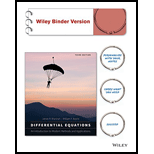
Concept explainers
In each of Problems
Want to see the full answer?
Check out a sample textbook solution
Chapter 5 Solutions
Differential Equations: An Introduction To Modern Methods And Applications 3e Binder Ready Version + Wileyplus Registration Card
Additional Math Textbook Solutions
Thinking Mathematically (6th Edition)
Probability And Statistical Inference (10th Edition)
Calculus: Early Transcendentals (2nd Edition)
Elementary Statistics: Picturing the World (7th Edition)
- You buy a house for $210000, and take out a 30-year mortgage at 7% interest. For simplicity, assume that interest compounds continuously. A) What will be your annual mortgage payment? $ per year B) Suppose that regular raises at your job allow you to increase your annual payment by 6% each year. For simplicity, assume this is a nominal rate, and your payment amount increases continuously. How long will it take to pay off the mortgage? yearsarrow_forwardPlease help me answer this question!. Please handwrite it. I don't require AI answers. Thanks for your time!.arrow_forwardSolve the following heat equation by method of separation variables: ди = at subject to u(0,t) =0, for -16024 ძx2 • t>0, 0 0, ux (4,t) = 0, for t> 0, u(x, 0) = (x-3, \-1, 0 < x ≤2 2≤ x ≤ 4.arrow_forward
- Your employer automatically puts 5 percent of your salary into a 401(k) retirement account each year. The account earns 8% interest. Suppose you just got the job, your starting salary is $40000, and you expect to receive a 2% raise each year. For simplicity, assume that interest earned and your raises are given as nominal rates and compound continuously. Find the value of your retirement account after 30 years Value = $arrow_forwardex 5. important aspects. Graph f(x)=lnx. Be sure to make your graph big enough to easily read (use the space given.) Label all 6 33arrow_forwardSuppose that a room containing 1300 cubic feet of air is originally free of carbon monoxide (CO). Beginning at time t = 0, cigarette smoke containing 4% CO is introduced into the room at a rate of 0.8 cubic feet per minute. The well-circulated smoke and air mixture is allowed to leave the room at the same rate. Let A(t) represent the amount of CO in the room (in cubic feet) after t minutes. (A) Write the DE model for the time rate of change of CO in the room. Also state the initial condition. dA dt A(0) (B) Solve the IVP to find the amount of CO in the room at any time t > 0. A(t) (C) Extended exposure to a CO concentration as low as 0.00012 is harmful to the human body. Find the time at which this concentration is reached. t= minutesarrow_forward
- Newton's Law of Cooling tells us that the rate of change of the temperature of an object is proportional to the temperature difference between the object and its surroundings. This can be modeled by the differential equation dT dt k(TA), where T is the temperature of the object after t units of time have passed, A is the ambient temperature of the object's surroundings, and k is a constant of proportionality. Suppose that a cup of coffee begins at 178 degrees and, after sitting in room temperature of 61 degrees for 12 minutes, the coffee reaches 171 degrees. How long will it take before the coffee reaches 155 degrees? Include at least 2 decimal places in your answer. minutesarrow_forwardDecide whether each limit exists. If a limit exists, estimate its value. 11. (a) lim f(x) x-3 f(x) ↑ 4 3- 2+ (b) lim f(x) x―0 -2 0 X 1234arrow_forwardcan you help me solve this question and show workings pleasearrow_forward
- how could the bar graph have been organized differently to make it easier to compare opinion changes within political partiesarrow_forwardketch a graph of the function f(x) = 3 cos (표) 6. x +1 5 4 3 3 80 9 2+ 1 -9 -8 -7 -6 -5 -4 -3 -2 -1 1 2 3 4 5 6 7 -1 -2 -3+ -4 5 -6+ Clear All Draw: пи > Next Questionarrow_forwardDraw the following graph on the interval πT 5π < x < 2 2 y = 2 sin (2(x+7)) 6. 5. 4 3 3 2 1 +3 /2 -π/3 -π/6 π/6 π/3 π/2 2π/3 5π/6 π 7π/6 4π/3 3π/2 5π/311π/6 2π 13π/67π/3 5π Clear All Draw:arrow_forward
- Algebra & Trigonometry with Analytic GeometryAlgebraISBN:9781133382119Author:SwokowskiPublisher:Cengage
